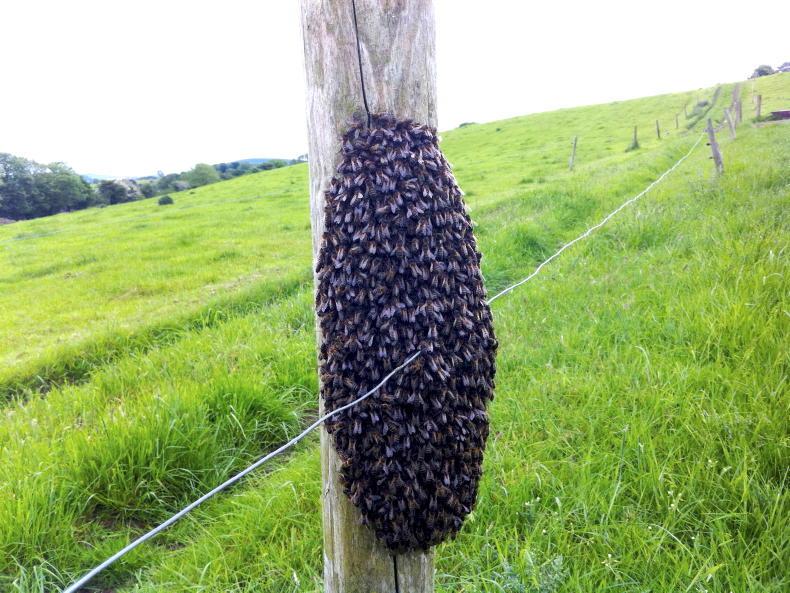Ask any beekeeper about their bees swarming and they are sure to recount the age-old maxim: “a swarm in May is worth a cock of hay, a swarm in June is worth a silver spoon, a swarm in July isn’t worth a fly!”
Make no doubt about it, but bees are complicated. Aristotle, who had a firm handle on most things in this world, found the workings of the beehive a complete enigma. An ancient Irish triad drives home the degree of bee complexity in its own peculiar fashion: An trí ní is deachair a thusicint, Obair na mbeach, intinn na mban agus teacht agus imeacht na taoide! (Three things most difficult to understand, the work of the bees, the minds of women, the coming and going of the tide!)
May and June are essentially make it or break it months for the beekeeper and the biggest factor here is that of gaining or losing a hive because of swarming. Swarming is the bees’ natural way of reproducing. It takes place when the queen and the majority of the female workers up and leave the hive in search of a new abode, leaving the young and, as yet, non-flying bees back in the hive.
There are all sorts of reasons that promote swarming, but one that is inevitable is when the old queen is no longer able to fertilise her eggs. During the spring and summer, astonishingly, the queen lays somewhere between 2,500 and 3,000 eggs per day. When she fertilises her eggs, her offspring are female; if not, they are the male drones. The drones do very little in the hive: they do not collect pollen or nectar but simply sit around eating all around them, waiting for the opportunity to mate with a new queen.
If the queen loses her fertility, the hive will very quickly fill with drone cells and newly hatched drones and this is enough to set the female worker bees building extensions on to the normal hexagonal cells, so that some of the female worker bees can grow to a fuller size.
In turn, the young larvae that are destined to pupate into queens are fed with extra nourishing royal jelly and so grow larger. Any hive can have anything up to 10 or 20 of these queen cells and that is what has all the beekeepers losing sleep at this time of the year. If they see queen cells, they know that the hive is getting ready to swarm and it is very difficult to stop this process. If the bees go at the wrong time, it will take some time for it to re-establish itself and there will be very little honey.
Insect nightclub
Once the new queen emerges from her cell, she is a virgin queen and must be mated. To do this she flies up into the air to what is called the “drone congregation zone”, a sort of flying insect nightclub and here, in flight, she is mated by anything from five to eight different drones, all of whom die in the mating process. When she returns to the hive, she carries enough sperm to last her about two and a half years. The old queen and her swarm will have vacated the hive and will search out a suitable spot. Their natural habitat in the distant past would have been the hollowed centres of old trees in the woodlands. Nowadays, it is most often the attic space of a house entered through the smallest of gaps between fascia and soffit.
En route to such locations, the bees may alight and rest for a while, often settling on a branch of a tree, a fence post or an old farmgate. The swarm is in the shape and size of a large oval rugby ball. I have seen them cluster on the crossbars of bicycles and on the wing mirrors of cars, while one swarm tidied themselves neatly into the interior of a traffic cone in the middle of some busy roadworks. Most beekeepers will set up a few bait hives, complete with some old drawn comb and if the accommodation is suitable, the scout bees will lead the queen and her swarm to their new abode. In time, the displaced colony will bring on a new queen and once mated, she will take over in a process called “supersedure”.
Sinking feeling
Any beekeepers reading this will be fully aware that this is just one general account of an endless list of scenarios of how and why and when bees swarm. Beekeepers dread the swarm. They will be aware of the sinking feeling when they go to their apiary to find that their best and strongest hive that was full of bees a few days before is now practically empty and it will be weeks before it will recover, if at all. Equally, they are aware of the immense sense of satisfaction, when having rescued and re-hived a large swarm, the bees settle back to collecting the pollen and nectar and become a new colony in the apiary.
In June, this new hive will have time to increase and to gather the nectar for honey, especially when the main flow of clover and blackberry is available throughout July. Equally, because it has already swarmed, this new colony is unlikely to swarm for some time again and hence as the maxim declares, a swarm in June is worth a silver spoon.
Shane Lehane is a folklorist who works in UCC and Cork College of FET, Tramore Road Campus. Contact: shane.lehane@csn.ie






 This is a subscriber-only article
This is a subscriber-only article










SHARING OPTIONS: